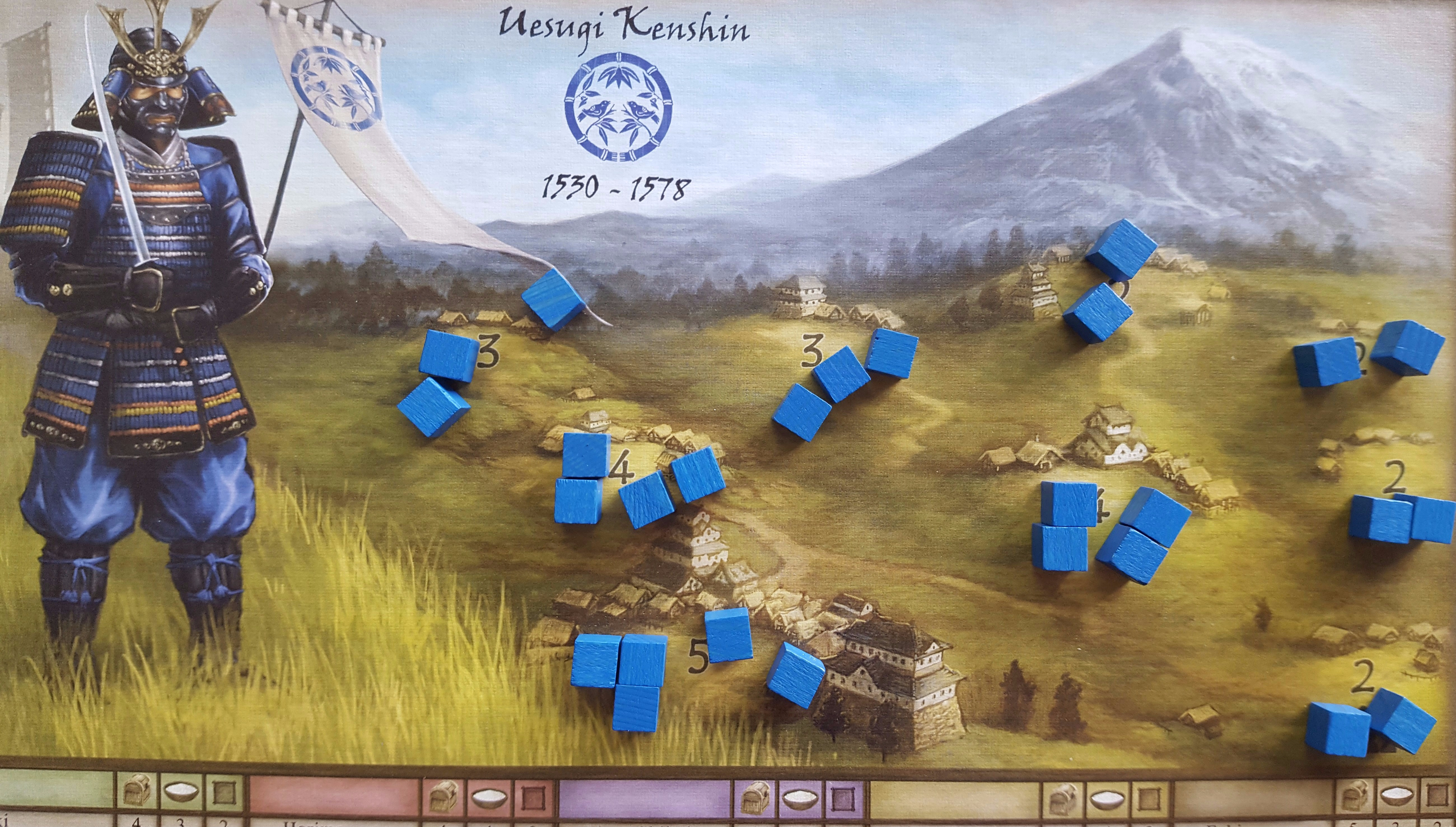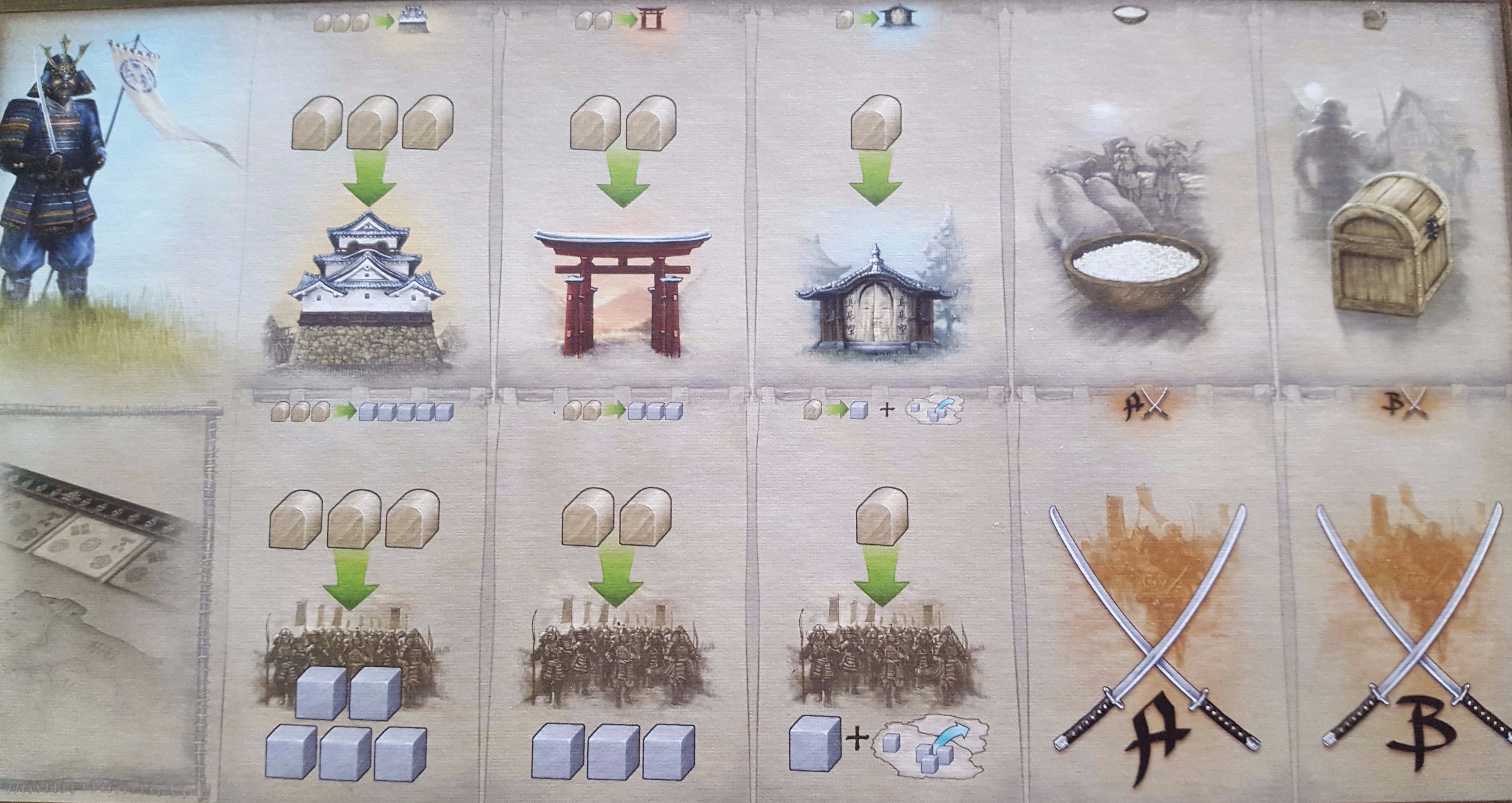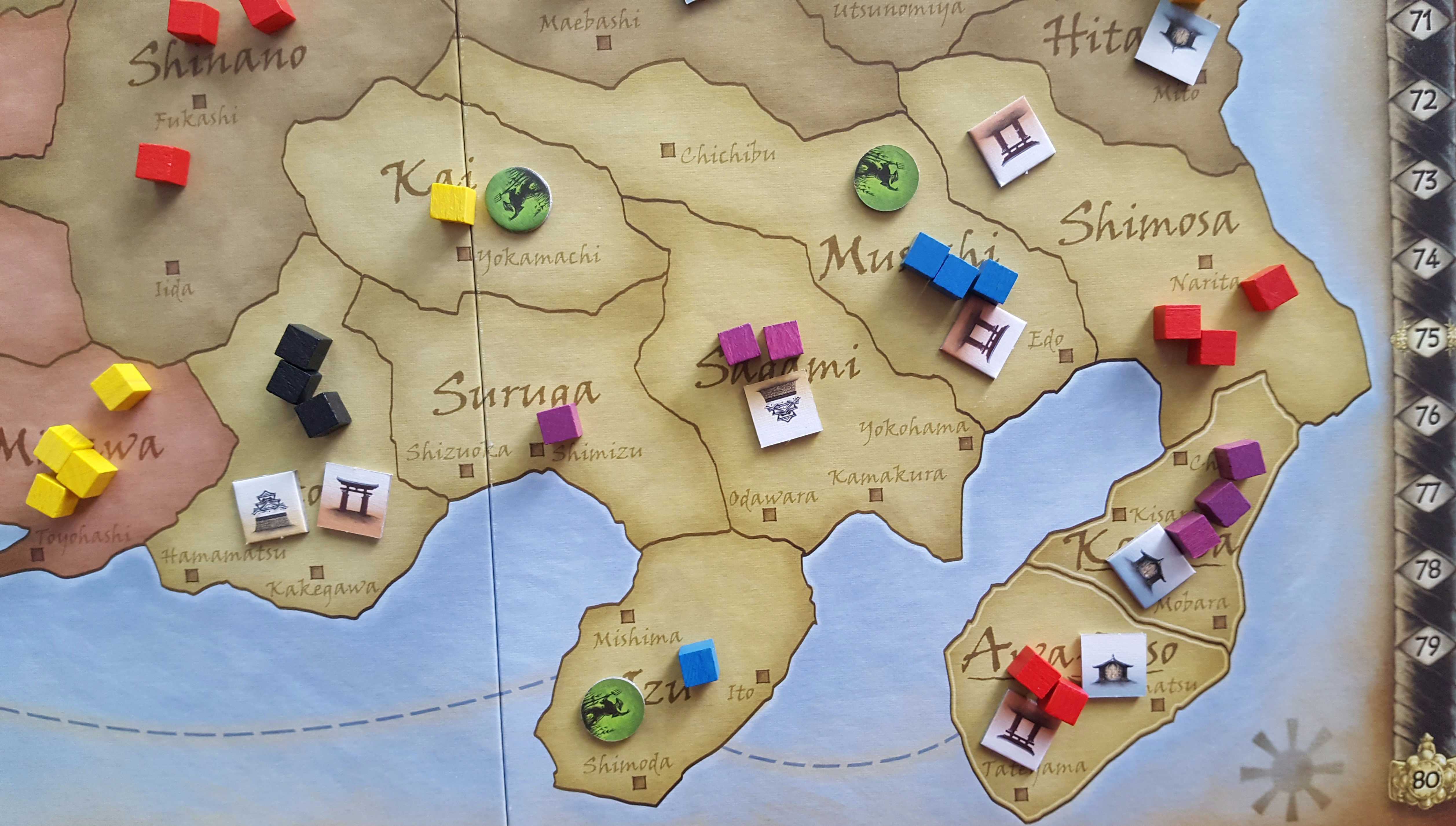Shogun Review
July 22, 2017In Shogun, three to five players take on the role of a Daimyo vying for control over the many provinces of 16th century Japan. The game is broken down into two years, each of which is further broken down into four seasons. The player with the highest number of points at the end of the game will be named SHOGUN.
During setup, players fill the front side of their player boards with eight or nine (depending on player count) army groups, represented by cubes. These groups vary in size from two to five. To claim starting provinces, the province deck is shuffled and the top two cards turned face up next to it. Starting with the oldest player, they can choose one of the face up provinces, or choose blindly from the top of the deck. Once a province card is chosen, it is added to their hand, and they now deploy any one of their eight/nine army groups from their player board into the corresponding province on the game board. If a face up card was chosen, it is refilled from the top of the deck, and the next player in clockwise order chooses a province card.

Blue player’s army groups ready to deploy
Players continue to do this until they have deployed all of their army groups onto the board. Any provinces on the game board that do not have player armies in them are considered to be neutral provinces. In addition to their starting province cards, players will also receive five war chest cards depicting values of zero to four. These cards are used to bid for turn order.
Each Spring, Summer and Fall, the players will be bidding for turn order and programming ten action spots on the back side of their player boards. They do this by selecting one of the province cards that corresponds to a province that they control, and place it facedown on the action spot that they wish to perform in that province. The ten action spots are:
- Build a Theater for one war chest
- Build a Temple for two war chests
- Build a Castle for three war chests
- Confiscate Rice (to feed armies in Winter)
- Collect Taxes (which gets you warchests)
- Pay three war chests to deploy five armies
- Pay two war chests to deploy three armies
- Pay one war chest to deploy one army and/or move any number of armies from this province into an adjacent, player controlled province
- Attack/Move armies A
- Attack/Move armies B

Action selection board
Before players do this, however, the order in which these actions resolve during a season is randomly determined. The ten action cards are shuffled and laid out next to the game board. The first five are turned face up, the last five stay face down.
After players have programmed their actions, a season event is determined. These event cards have many effects that can influence gameplay, but can have the most devastating effect during Winter. When all actions have been carried out during Spring, players repeat the process through Summer and Fall.
Once Winter hits, actions are not taken in this season, nor is an event applied. Instead, players will feed their armies from their rice reserves and then score points. To feed a player’s armies, they must pay one rice per province they control. They will also need to pay rice equal to the penalty depicted on the event card. These penalties can range from -1 to -7 units of rice. If players do not have enough rice to pay for their armies, they will have to resolve one or more revolts. Revolts occur anytime a province’s farmers become unhappy, like when a player repeatedly collects taxes or confiscates rice. When a revolt occurs in a province, a player’s armies must fight a number of farmers that correspond to the number of revolt tokens in that province.
If the farmers are successful, that player loses control of that province, all buildings in that province are removed from the board, and the player removes the province card from his hand, returning it back to the province deck. If the player quells the revolt, all surviving army cubes are put back into that province, along with a revolt token, retaining any tokens that may have been added in previous seasons this year.
After paying rice, players then score points. Each player receives one victory point for each province they control and one victory point for each building they control. Players will also score majorities in each region. The most castles scores you three points, the most temples scores you two points and the most theaters scores you one point.

Purple and black player tie for palace majority. Red player scores temple majority. Purple and red player tie for theater majority.
After Winter of the first year, all revolt tokens are removed from the board, new events are selected, and the players start in Spring again. After the second year, the game ends.
Man, I love this game! It has rocketed to the top of my favourites list of my collection. One of the coolest parts about it is the combat system. You just pick up all of the attacker’s cubes, and all of the defender’s cubes and then dump them in the cube tower. The tower has two inserts in it that catch some of the cubes when put through it, so not all cubes are guaranteed to come out when thrown in. At the beginning of the game the tower is seeded with players cubes and some green farmer cubes.
Cubes of the combating players are removed one for one until a player has no cubes left in the tray. The player who does have cubes left is the winner. It really keeps combat simple and sleek and doesn’t bog the game down at all. Especially when combat plays a hug part of any area control game.
The tower is also the biggest component of luck in the game. Similar to improving your odds in dice combat by using more troops, which give you more dice, you can try to mitigate the luck of the tower by throwing in ALL THE CUBES. The best part about it is always having that slim chance to pull off an upset. Throwing in two cubes against six and coming out on top. Even that swingy aspect is self balancing though, since potentially, that player just got six more cubes in the tower that could come out on future attacks. Which now improves their odds when they need to go for that long shot attack. There is a ton of power in having cubes in that tower.
I made a pretty dumb mistake during one of my plays. I attacked a huge force, with expectations to lose, but I wanted to try and soften up the army group in that province for future attacks. I lost, but wiped out a huge chunk of their forces, all because their cubes got caught in the tower. My second attack during that season was against the same opponent, a province I desperately needed to get to steal a region majority from them for palaces. They slaughtered me in that second attack when all of those extra cubes I help them put in there came spilling out of the tower.
The meat of the game comes in adapting to the random order of action resolution while trying to predict what your opponents will do in each of their provinces AND taking into consideration what has or has not come out of the cube tower. And the fact that you can only do a single action with each province per season can be so limiting if you don’t plan well. It seems like every single season I need to do two or three actions in the same province and have to prioritize which one needs to be done based on board state.
There seems to be two main extremes of very viable strategies to take, boiling down to hyper aggression or straight infrastructure. You could solely focus on only attacking provinces your opponents have already built structures in, ignoring building your own, and spending all of your war chests on the troop deployment actions and controlling turn order.
However, your rampaging is kept in check and tempered by the way the move/attack action works. Movement is very limited in Shogun, you only get to move a maximum of three provinces worth of armies to an adjacent province; one of which must already be controlled by you when using the deploy one troop and/or move troops action. So you can go ahead and build up a huge force in one province, putting all of your eggs in one bloated, slow moving basket, most assuredly leaving you weak in other areas of the board. This could be where you find yourself needing to take multiple actions in the same province in a given season but just can’t. While you’re marching your massive army across the board and slowly taking casualties, and leaving some defenders behind to protect those juicy buildings you just worked so hard to take from your opponents, you’ll have to stop and reinforce.
This will give your opponents a chance to react to your wicked death march, either by trying to mount a counterattack on your forces while you’re weak, or by shoring up their own defenses in that province with that sweet majority winning palace that you clearly have your sights set on.
During the initial province draft to setup the game, you would want to focus on getting provinces with high war chest values to give you the most flexibility when collecting taxes to fund the mass amount of troops you’ll need to deploy. This will help you spread out the revolt tokens and hopefully not lose and provinces to the farmers. You’ll also want to snag provinces that will just put you next to as many of your opponents as possible. Very few provinces on the game board have less than two other provinces adjacent to it, making it easy to always have a potential war front to march to, seeking out buildings.
The infrastructure route is the other side of that coin, spamming out as many buildings, as quickly as you can, spending your war chests only on structures. When province drafting for this strategy, you’ll want to look for provinces that can hold the most amount of building spaces. Provinces can hold one to three structures, and only one of each type, max. You’ll also want to make sure to establish a presence in each region so you are always in the running to score the majority points for structures.
After the first year, you can jump way ahead in points pretty easily if you score majorities in most of the regions. Like the aggression tactic, this tactic balances itself from being too powerful. You can spend an entire year building one of each structure in your province that has three building spaces, but that means you haven’t spent a single round reinforcing that province to protect it. And with each building you put in there, it becomes a bigger and better target for your opponents to try and take from you. Allowing them to grab those points you worked so hard to build.
Obviously the best thing to do is find that perfect balance between the two extremes. That balance is going to be in a different spot of the teeter totter every game. Hell, in every round. Another great part about this game is how nothing is ever static. It forces players to adapt their tactics to the ever changing board state, and possibly even change their whole strategy halfway through the game. The biggest example of that is in the action resolution. The game gives the players just enough information in those first five face up actions to make an educated guess on the best way to program their actions. It also gives players an idea of how much of a gamble programming certain actions could be and allows them to decide if they want to take that risk.
Will collect taxes come up before build a palace? Because I am flat broke from throwing out all these damn armies onto the board from last round! Or maybe I forgo deploying troops entirely and save my war chests so I can build that theatre? Which will be just enough to steal majority in that region.
In my opinion, the game always gives you enough info to be able to mitigate any randomness that occurs in the way the actions resolve. And since every player is dealing with the exact same randomness, it works well as a game mechanic.
The revolt tokens and rice management is interesting, but I’ve never really seen it become a big deal. I’ve seen players just repeatedly collecting taxes or confiscating rice from the same province over and over again, essentially sacrificing one victory point to ensure that they could feed their armies or pay for all of their actions. Not to mention stacking revolt tokens in a province makes it less and less enticing for a player to take from you, even if you only have a couple of armies in there. Though, this is only partially true, since after each Winter, all revolt tokens are removed from the board for the next year.
I actually don’t like this. The first couple games we played incorrectly and left all the revolt tokens on the board throughout the entire game. It made for some much more difficult decision late game on where to confiscate and collect from, often times forcing you to cause a revolt in a province with one or more buildings in it, potentially causing you to lose huge chunks of points.
Admittedly, this does inject a bit more randomness into the game, as you would have to use the cube tower more often, but I think it offers the players a chance to make more impactful and difficult decisions. And it serves to compound the risk of loss when causing a revolt. As more farmer cubes are thrown into the tower, the higher chance of farmer cubes staying the tower. Making the odds of quelling a future revolt drop.
I’ve seen the rice play even less of a role in the game. It’s been pretty rare for a player to not be able to feed all of their armies in my plays of the game. And even when they can’t the revolts are usually quelled fairly easily.
I do think that this could play a bigger role with more experienced players of the game though. The player boards have a summary of each province and their rice, war chest and building space values. Using that info, players could try to target provinces with the highest rice values, hoping to steal that province from a player before they can confiscate rice from there.
Even that tactic depends on the action resolution though, if confiscate rice comes up before either of the attack/move actions, then there isn’t much players can do about that as far as direct interaction goes. But you would still be taking a high valued province from that player for future seasons, so I can see how it could still be impactful. And if you have a full table of players trying to do that to every other player, somebody is going to get the short end of that stick and be left without rice. All that just adds another layer of decisions players have to make, not just needing to protect their buildings, but also to protect their high value resource provinces as well.
On to player count. I have played at all numbers of players, three, four and five. The game really does play will at all player counts. At three, you remove eight province cards from the deck, shrinking the map to fit the count. Those removed provinces are outlined in white on the game board to remind players that they can not move their armies into those provinces. The scaling board keeps the player interaction high. You are still always surrounded by your opponents, assuming they all drafted well.
At five players, every province on the board will be filled with a player’s armies, leaving no neutral provinces that can easily be scooped up for points. It can also get very chaotic late game. There gets to be so many choices you and your opponents can make on who/where to attack, where to deploy to defend, where’s safe to build a structure. Often it ends up being a bit of a crapshoot if your plans actually come to fruition or not. There are many more opportunities for your schemes to be foiled, and less chance to predict how to stop them from being so.
That leaves four, making the porridge just right. This is the optimal player count for sure. You get the best of both worlds, tons of player interaction and counterplay, but with a bit of breathing room in some of those neutral territories that give you a chance to actually be able to predict what your opponent’s best move might be. Four peeps is the way to be.
The only negative things I really have to say about Shogun is the outdated and bland look of the boards and components. But they’re entirely functional and I personally don’t really care that they’re just cubes. They’re brightly coloured and stand out on the board against the coloured regions, so it’s not an issue for me. The player boards are great cardstock though. I punched over an entire cup of coffee onto one of them and it just wiped right off, didn’t even leave a stain. Thank goodness too, because I was pissed as hell at myself!
The other slight negative I can see some people having is the length of play at the full five player count. Programming the actions during Fall, Spring and Summer can definitely cause a little analysis paralysis.
Also, as cool as the cube tower is as a game mechanic, once you’ve seeded it with everybody’s armies and the farmer cubes at the beginning of the game, DO NOT MOVE IT. Don’t even yell near it! It is very easy to bump the table or even bump the tower itself while resolving combat, causing more cubes to fall out at inopportune times.
Outside of combat this isn’t a big deal, you can just leave them in the tray and throw them all back in with the next combat. You do the same thing with cubes that belong to a player who is not participating in the combat if they happen to fall out when resolving.
I would just recommend making sure all players agree on what to do if extraneous cubes fall out due to tower contact before starting the game. Again, it’s not really a big deal, you can just throw them all back in the tower and resolve the combat again, but it will inevitably occur during a huge battle that will decide the fate of Japan and one player will get upset over the win that is now a loss or vice versa.
In summary, I highly recommend Shogun, even for less experienced gamers. It may take a season to fully understand how the game works, but it’s great when you see it click for a new player and they seem to climb inside your head and route around in there, blocking your every damn attempt at getting some points on the board!
There is an expansion out there called Tenno’s Court and it comes with a mini expansion called Samurai. I’ve never played them so I can’t comment on how they affect the game. I do want to try them, even though I feel like there is a ton of game in the base box and really don’t see it becoming stale anytime soon. Maybe I’ll pick them up and do a follow up review on how they play. Let me know if that would interest anybody. Anyways, get this game! Or better yet, come on over and we can play it together! Thanks for reading.
L.

